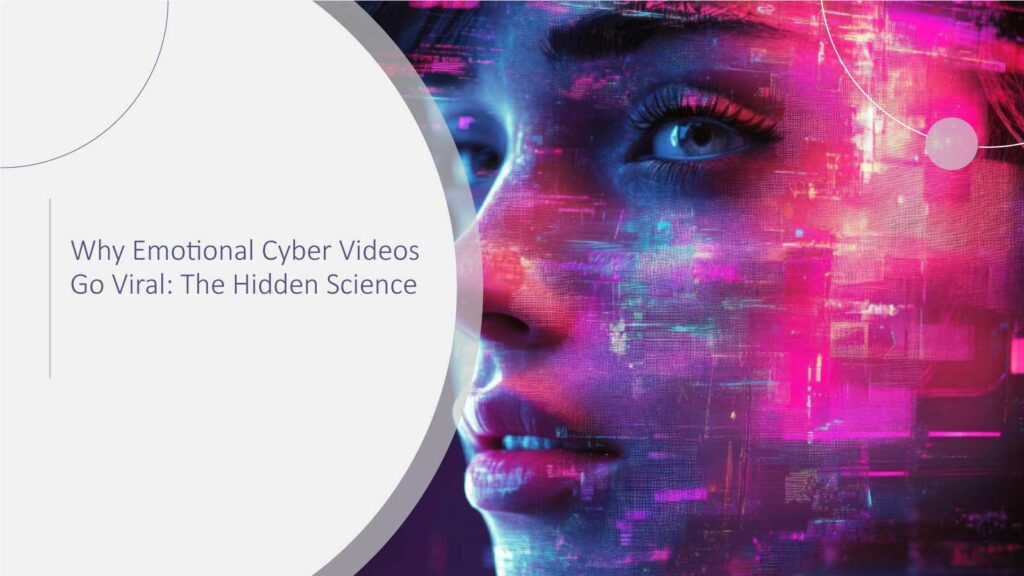Have you ever clicked on a video that didn’t seem special but made you watch, react, and share it? Certain videos in today’s overly packed digital world are able to distinguish themselves and spread quickly, but the question remains: what makes them go viral? In most cases, the answer to these is a combination of emotion and storytelling. According to a study by Forrester Research, between 2011 and 2014, higher emotional-engagement dimensions led to a 13% increase in customers’ enjoyment of their experience. Emotionally charged cyber videos instrumentally combine human stories with technology themes and consequently, generate enormous reactions that in turn fuel the conversations.
This piece of writing not only unravels the scientific aspect of such videos but also provides insights to professionals, tech enthusiasts, and busy executives who are willing to learn about this phenomenon.
What Are Emotional Cyber Videos?
The first thing that comes to mind when we talk about an emotional cyber video is definitely not a technical demonstration. The scenarios can be a squad that is desperately trying to stop a ransomware attack, figures steadily rising on the threat activity dashboard, or maybe even the feeling of relief when the systems get their power back. These videos blend:
- Cyber technology themes: incident response, AI threat detection, ethical hacking.
- Emotional storytelling: suspense, awe, relief, or inspiration.
- Visual cues: animations, live dashboards, or alerts that make abstract threats tangible.
After all, with the help of these videos, the complex technology, which at first glance seems very difficult to comprehend, becomes very understandable or even relatable to the viewers. Hence, these videos are more effective than traditional tutorials or whitepapers in engaging audiences. A McKinsey study reports that tech content paired with human storytelling can increase engagement by 40–50%.
The Science Behind Virality
High-Arousal Emotions
One of the things that research conveys consistently is the fact that content that evokes the so-called high-arousal emotions, that is, emotions say those of awe, surprise, anger, or anxiety, has more shares than the content that is either neutral or low-arousal emotion. To put it differently, after watching a video that makes your heart beat faster or gives you goosebumps, you very much want to share it.
Novelty and Surprise
What surprise does is to intensify emotion. To keep the suspense and the followers’ engagement up, as well as brand their intention to share the content, video producers are mainly using unexpected twists. For instance, a terrific idea could be to let the watchers visualize the ongoing real-time intervention of AI as it stops the cyberattack. This will make the situation novel, hence grabbing attention.
Social Sharing of Emotions
Emotional experiences are something people usually share. This phenomenon fuels the concept of viral content, especially when the content in question is not only relatable but also resonates with professional concerns.
Platform Amplification
Quickly submitted requests for content (likes, comments, or shares) are what the system’s algorithms that support social networking platforms look for, in order to decide whether content is ‘hot’ or not. The reason emotionally charged videos receive quick responses is that the array of possible actions is large and quick; social media users can like, share, and comment when these videos appear, and this is feedback for the social platforms, which speed the video dissemination plans to capitalize on the high reach potential. In a blog by Gartner, Inc. on personalized video, they note that personalized video content ‘makes a strong emotional connection’ and in one case study, 58% of viewers of the first video then enrolled (in a university case).
Why Cyber Videos Go Viral?
Cyber videos uniquely benefit from the capability to show effects that people don’t see and associate them with reality. Main points of their viral potential are:
- Relevance: Security incidents are the concern of the executives and the people running the company, thus making the content of the video immediately relevant for tech leaders. According to McKinsey & Company, engaging, audience-focused narratives can elevate morale and inspire actions across organizations.
- Human Stories: Depicting the real teams or the roles that are going through the cyber crises not only establishes empathy but also the connection.
- Fear and Hope: Cyber videos normally show a threat scenario and then the solution, creating emotional peaks of almost equal measure.
Working on the Emotional Cyber Videos That Spread
Making videos that people feel and want to share requires the following:
- Catch your audience’s attention within 5–10 seconds: visual tension or alerts can be used to pique interest.
- Focus on the human protagonists: Incident responders, CISOs, or security analysts can help the audience relate to the story.
- Make the cyber threats and the solutions visible: Live dashboards, animations, and alerts give a tangible form to abstract issues.
- Apply emotional peaks as a plot device: Discovery, suspense, and relief moments help to keep the attention of the audience.
- Invite sharing unobtrusively: Finish with the statements that your audience can relate to, like “Share if you’ve experienced a network alert panic.”
- Engagement should also be measured: Engagement, share, and view-through rates, as well as sentiment, provide useful insights.
Key Takeaways
Sharing is largely driven by the participation of the viewer’s emotions: Videos that evoke awe, surprise, and a sense of urgency can be easily shared, being more prone to going viral.
Human + tech = resonance: The impact of the message is doubled when a cyber story is coupled with a relatable human narrative.
The strategy used is important: The method employed, including platform timing, metadata, and performance analytics, is what ultimately determines the power to be put to use.
Conclusion
Emotional cyber videos are not only captivating pieces of content; they serve as tactical instruments that link technology with human experience. By blending high-arousal emotions, relatable narratives, and lucid visualization of cyber threats, these videos manage to capture the audience’s attention, make the sharing process smooth, and increase their influence on the wide professional and tech-savvy community.
As a result, the organizations and the professionals who grasp the covert science of virality are enabled to conjure contents that resonate with viewers, educates them, and drives measurable engagement. In the fast-paced cyber world, the use of emotion is not elective; rather, it’s a prerequisite for having a significant digital influence.
FAQs
Q1: What emotions lead to sharing in cyber videos?
By far, the most potent high-arousal emotions leading to sharing are awe, surprise, anxiety, or relief.
Q2: Are positive emotions better than negative ones?
Both can be successful if they are high-arousal. Most of the time, positive emotions like awe or inspiration outperform the rest.
Q3: What is the ideal length for an emotional cyber video?
Retention and sharing are mostly done by people watching shorter videos (1–3 minutes) with a compelling opening.
Q4: Is it possible to design viral videos?
While emotion is a major factor, the combination of novelty, human relevance, and platform optimization is what really maximizes the chances of sharing.
Q5: What are the ways to measure effectiveness?
Effectiveness could be measured through different metrics: the number of shares, the view-through rate, comments, sentiment, and the general trend of engagement. All these should be tracked in order to understand the content’s resonance.
Don’t let cyber attacks catch you off guard – discover expert analysis and real-world CyberTech strategies at CyberTechnology Insights.
To participate in upcoming interviews, please reach out to our CyberTech Media Room at info@intentamplify.com.


